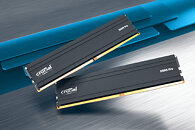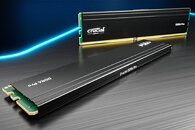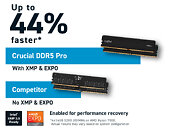TheLostSwede
News Editor
- Joined
- Nov 11, 2004
- Messages
- 18,472 (2.47/day)
- Location
- Sweden
| System Name | Overlord Mk MLI |
|---|---|
| Processor | AMD Ryzen 7 7800X3D |
| Motherboard | Gigabyte X670E Aorus Master |
| Cooling | Noctua NH-D15 SE with offsets |
| Memory | 32GB Team T-Create Expert DDR5 6000 MHz @ CL30-34-34-68 |
| Video Card(s) | Gainward GeForce RTX 4080 Phantom GS |
| Storage | 1TB Solidigm P44 Pro, 2 TB Corsair MP600 Pro, 2TB Kingston KC3000 |
| Display(s) | Acer XV272K LVbmiipruzx 4K@160Hz |
| Case | Fractal Design Torrent Compact |
| Audio Device(s) | Corsair Virtuoso SE |
| Power Supply | be quiet! Pure Power 12 M 850 W |
| Mouse | Logitech G502 Lightspeed |
| Keyboard | Corsair K70 Max |
| Software | Windows 10 Pro |
| Benchmark Scores | https://valid.x86.fr/yfsd9w |
Last year, Crucial canned its Ballistix brand of gaming focused memory, but it seems like the company still wants to offer its customers a more premium product, as Crucial has just introduced its new Pro series of memory products. Crucial will offer its new Pro series in both DDR5 and DDR4 flavours at either DDR5-5600 or DDR4-3200 speeds. It should be noted that the DDR4 modules still rely on a green PCB, while the DDR5 modules get the same black PCB as Crucial's regular DDR5 modules. Beyond the heatsink, there isn't much that differs between the Pro series and Crucial's regular modules, but there is one thing that might matter to potential buyers.
Crucial has added support for AMD EXPO and Intel XMP 3.0 to its Pro series of modules. In the case of AMD EXPO this only applies to DDR5 modules, whereas the DDR4 modules support Intel XMP 2.0, in this case a feature its standard DDR4 modules lack. This should make it easier for end users to take advantage of the extra performance offered by some of these modules. That said, as Crucial has stuck to JEDEC timings, taking the Pro DDR5-5600 UDIMM kit as an example, you end up with timings of 46-46-45-45 at 1.1 Volts, where competing products have timings in the range of 36-36-36-36, although usually at 1.25 Volts or higher. Even as far as JEDEC timing goes, Crucial has chosen the middle ground for DDR5 5600, as there is a timing option from JEDEC that supports 40-40-40-40, which would make more sense for a more premium product. Price wise, a 32 GB kit with two 16 GB modules of DD5-5600 modules carries an $11 price premium over Crucials standard modules, with a retail price of US$114.99 versus US$103.99, but there are better options out there at this price point.



View at TechPowerUp Main Site | Source
Crucial has added support for AMD EXPO and Intel XMP 3.0 to its Pro series of modules. In the case of AMD EXPO this only applies to DDR5 modules, whereas the DDR4 modules support Intel XMP 2.0, in this case a feature its standard DDR4 modules lack. This should make it easier for end users to take advantage of the extra performance offered by some of these modules. That said, as Crucial has stuck to JEDEC timings, taking the Pro DDR5-5600 UDIMM kit as an example, you end up with timings of 46-46-45-45 at 1.1 Volts, where competing products have timings in the range of 36-36-36-36, although usually at 1.25 Volts or higher. Even as far as JEDEC timing goes, Crucial has chosen the middle ground for DDR5 5600, as there is a timing option from JEDEC that supports 40-40-40-40, which would make more sense for a more premium product. Price wise, a 32 GB kit with two 16 GB modules of DD5-5600 modules carries an $11 price premium over Crucials standard modules, with a retail price of US$114.99 versus US$103.99, but there are better options out there at this price point.



View at TechPowerUp Main Site | Source



